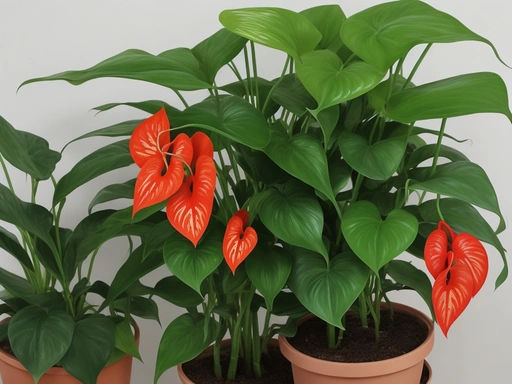Anthurium Common Pests: How to Keep Your Plants Pest-Free!
Key Takeaways:
- Spider mites are common pests that can infest Anthurium plants.
- Aphids can also pose a threat to Anthurium plants and should be closely monitored.
- Regular foliar inspections can help detect and prevent pest infestations on Anthurium plants.
- Proper maintenance and care, such as keeping the leaves clean and providing adequate ventilation, can help minimize the risk of pest attacks on Anthurium plants.
Are pesky pests ruining your Anthurium plant’s beauty?
Well, you’re not alone! Anthurium plants are susceptible to a variety of common pests that can wreak havoc on their leaves, stems, and overall health.
But why are Anthuriums such a target for these little invaders?
In this article, we’ll explore the environmental factors, lack of proper care, and vulnerability of Anthurium plants that make them attractive to pests.
We’ll also delve into the identification, symptoms, prevention, and control methods for the most common culprits, including mealybugs, aphids, spider mites, thrips, and scale insects.
So, get ready to arm yourself with knowledge and protect your precious Anthuriums from these pesky foes!
| Pest | Description | Damage |
|---|---|---|
| Spider Mites | Tiny insects that form webs on plant leaves | Yellowing and wilting leaves, stunted growth |
| Thrips | Small, slender insects that feed on plant sap | Silver-colored scars on leaves, distorted growth |
| Mealybugs | Soft, white insects that appear as cottony masses | Sap sucking, yellowing leaves, sticky honeydew secretions |
| Aphids | Small, soft-bodied insects that cluster on new growth | Distorted leaves, stunted growth, honeydew secretions |
Why are Anthurium plants susceptible to pests?
Anthurium plants are susceptible to pests due to environmental factors and a lack of proper care and maintenance. Additionally, their natural vulnerability makes them an easy target for pests.
Environmental factors
Environmental factors can play a significant role in making Anthurium plants susceptible to pests.
Factors like high humidity, lack of proper air circulation, and excessive moisture can create a favorable environment for pests to thrive.
Additionally, inconsistent temperature, improper lighting, and poor soil conditions can weaken the plants, making them more vulnerable to infestations.
Taking necessary steps to maintain optimal environmental conditions can help prevent pest problems and keep Anthurium plants healthy.
Lack of proper care and maintenance
Lack of proper care and maintenance can make Anthurium plants more susceptible to pests.
Overwatering or underwatering, poor lighting, inadequate fertilization, and neglecting to remove dead leaves can weaken the plant and make it more vulnerable.
Regularly inspecting and cleaning the plant, providing the right environmental conditions, and following proper watering and fertilizing practices can help prevent pest infestations.
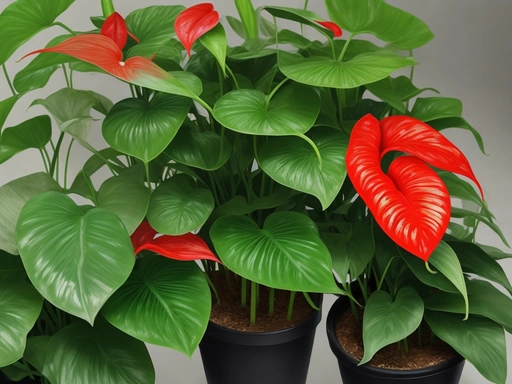
Vulnerability of Anthurium plants
Anthurium plants are vulnerable to pests due to the following factors:
- Environmental factors like high humidity and warm temperatures attract pests.
- Lack of proper care and maintenance weakens the plants, making them more susceptible to infestations.
- The natural vulnerability of Anthurium plants, such as their soft leaves and delicate flowers, makes them an easy target for pests.
Common pests that affect Anthurium plants
Anthurium plants can be affected by common pests such as mealybugs, aphids, spider mites, thrips, and scale insects.
Mealybugs
Mealybugs are a common pest that can affect Anthurium plants.
They are small, white insects that resemble tiny cotton clusters on the leaves and stems.
You may also notice a sticky residue on the leaves and stunted plant growth.
To control mealybugs, you can use natural remedies like neem oil or insecticidal soap sprays, introduce beneficial predatory insects, or use chemical insecticides labeled for Anthurium plants.
Regular application is key to prevent reinfestation.
Aphids
Aphids are tiny, soft-bodied insects that commonly affect Anthurium plants. They can be identified by their presence on leaves and stems.
Aphids cause damage by feeding on the plant sap and leaving behind a sticky residue.
Symptoms include curled or distorted leaves. If left untreated, aphids can weaken the plant and spread diseases.
To control aphids, you can use natural options like neem oil or insecticidal soap sprays, introduce beneficial predatory insects, or make homemade garlic or chili pepper sprays.
Chemical insecticides labeled for Anthurium plants can also be used, following safety precautions and regular application to prevent reinfestation.
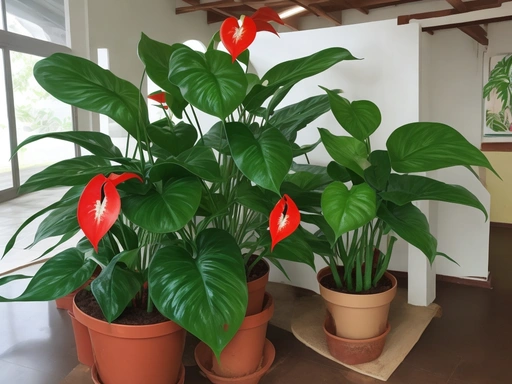
Spider mites
Spider mites are common pests that can affect Anthurium plants.
They are tiny pests that feed on the sap of the plant, causing damage and stress to the leaves and flowers.
Signs of a spider mite infestation include fine webbing on the leaves and flowers, yellowing or browning of the leaves, and stippling or speckling on the leaves.
It is important to take action to control spider mites to prevent further damage.
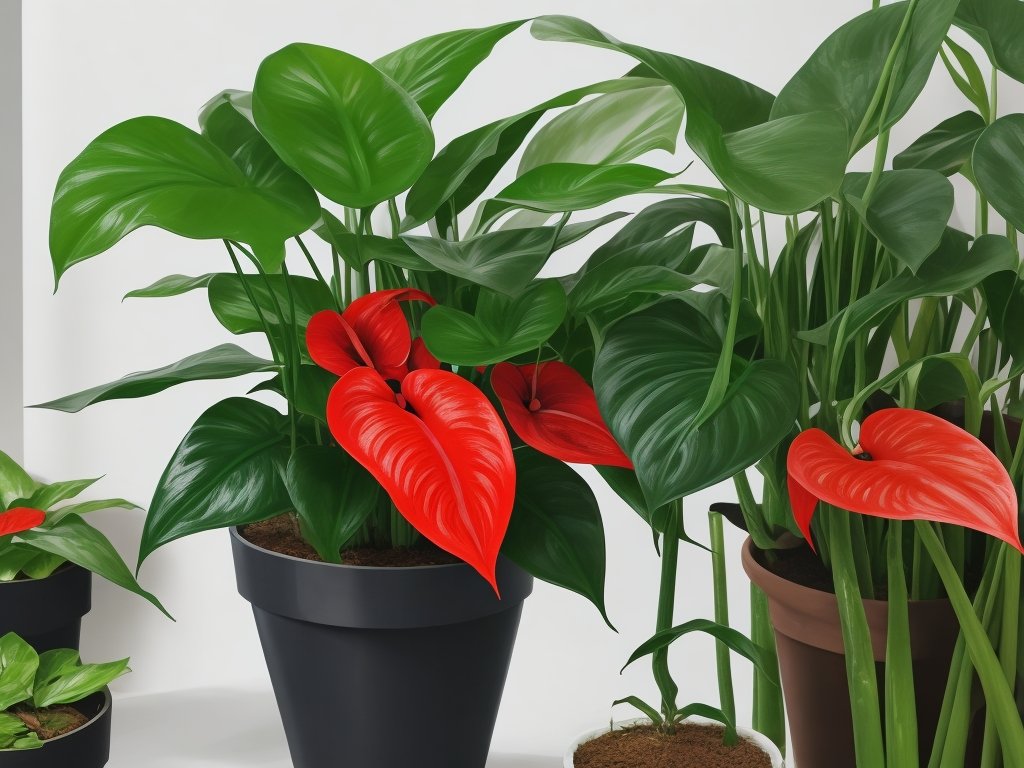
Thrips
Thrips are small insects that can be a common pest for Anthurium plants.
They can cause damage by feeding on the leaves and flowers, leaving behind silvery flecks, scarring, and distortion.
To control them, you can use natural remedies like neem oil or insecticidal soap sprays, beneficial predatory insects, or homemade garlic or chili pepper sprays.
Chemical control options are also available, but make sure to follow safety precautions and instructions.
Regular monitoring and proper care can help prevent thrip infestations in your Anthurium plants.
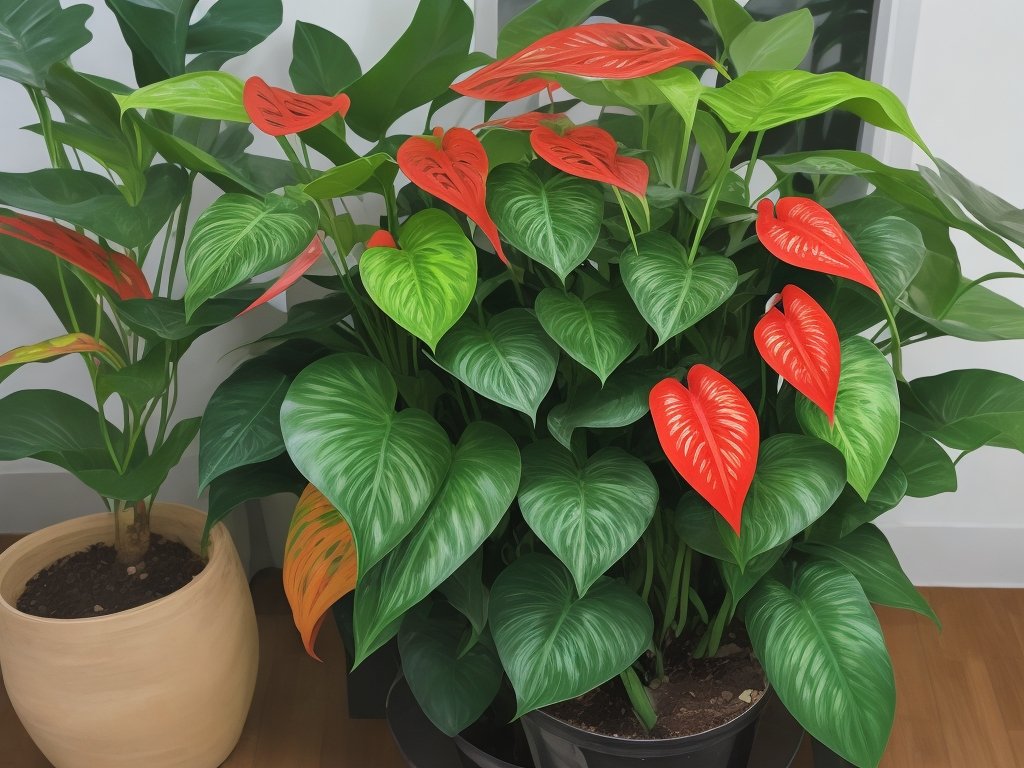
Scale Insects
Scale insects are a common pest that can affect Anthurium plants.
They appear as hard, oval-shaped bumps on stems and leaves.
Other symptoms include yellowing or wilting leaves and a sticky residue on the leaves.
To control scale insects, you can use cultural practices like regular cleaning and inspection, natural remedies like neem oil or beneficial predatory insects, or chemical insecticides labeled for Anthurium plants.
Identification and symptoms of Anthurium common pests
Here are some common pests that can affect Anthurium plants and their identifying symptoms.
Mealybugs
Mealybugs are common pests that can affect Anthurium plants. They appear as small, white, cotton-like clusters on the leaves and stems.
You may also notice a sticky residue on the leaves and stunted plant growth.
To control mealybugs, you can use natural options like neem oil or insecticidal soap sprays, beneficial predatory insects, or homemade garlic or chili pepper sprays. Chemical insecticides labeled for Anthurium plants can also be used, following safety precautions and applying regularly to prevent reinfestation.
White, cotton-like clusters on leaves and stems
White, cotton-like clusters on leaves and stems are a sign of mealybugs infestation on Anthurium plants. These tiny pests suck sap from the plant, leaving behind these “cottony” masses.
They can also cause sticky residue on leaves and stunted plant growth.
Sticky residue on leaves
Sticky residue on leaves of Anthurium plants is a common indication of a pest infestation.
It is often caused by insects such as mealybugs, aphids, and scale insects.
These pests produce a sugary substance called honeydew, which leaves a sticky residue on the leaves.
To address this issue, you can try natural remedies like neem oil or insecticidal soap sprays, introducing beneficial predatory insects, or using chemical pesticides labeled for Anthurium plants.
Regular inspection and proper care can also help prevent infestations.
Stunted plant growth
Stunted plant growth in Anthuriums can be caused by various factors. It could be due to environmental factors like inadequate light or improper temperature.
Lack of proper care and maintenance, such as insufficient watering or nutrient deficiencies, can also contribute to stunted growth.
Additionally, the vulnerability of Anthurium plants makes them susceptible to pests and diseases, which can hinder their growth. It’s important to address these issues promptly in order to promote healthy plant growth.
Aphids
Aphids are tiny, soft-bodied insects that can infest Anthurium plants.
They can be identified by their small size and can be seen on the leaves of the plant.
Aphids can cause damage by sucking the sap from the leaves, leading to curling or distorted leaves.
Sticky residue on the leaves is also a common sign of aphid infestation.
To control aphids, you can use insecticidal soap sprays or natural remedies like neem oil.
Regular monitoring and cleaning of your plants can help prevent aphid infestations.
Tiny, soft-bodied insects on leaves
Tiny, soft-bodied insects on leaves of Anthurium plants are commonly known as aphids. These pests can be identified by their small size and soft bodies.
They usually appear in clusters and can be various colors, such as green, yellow, or black.
Their presence can cause curling or distortion of leaves, as well as leave a sticky residue behind. Regular inspection and control measures can help prevent infestations.
Curling or distorted leaves
Curling or distorted leaves on an Anthurium plant can be a sign of pest infestation. Common pests like aphids, mealybugs, and spider mites can cause this issue.
Other factors like environmental conditions and improper care can also contribute to leaf curling.
Sticky residue on leaves
Sticky residue on leaves of Anthurium plants is often a sign of pest infestation, such as mealybugs or aphids.
These pests produce a sugary substance called honeydew, which leaves a sticky residue on the leaves.
Treating the pest infestation is crucial to eliminate the sticky residue and prevent further damage to the plant.
Spider mites
Spider mites are tiny pests that can cause problems for Anthurium plants. They create fine webbing on the leaves and flowers, and you may notice yellowing or browning of the leaves.
Another sign is the presence of stippling or speckling on the leaves.
It’s important to take action against spider mites to prevent damage to your plants.
Fine webbing on leaves and flowers
Fine webbing on leaves and flowers of Anthurium plants is a common symptom of a spider mite infestation. These tiny pests spin delicate webs as they feed on the sap of the plant.
Other signs include yellowing or browning of leaves and stippling or speckling on foliage.
Yellowing or browning of leaves
Yellowing or browning of leaves in Anthurium plants can be a sign of pest infestation or environmental stress.
Common pests like mealybugs, aphids, spider mites, thrips, and scale insects can cause these symptoms.
It’s important to identify the specific pest and take appropriate measures for prevention and control.
Stippling or speckling on leaves
Stippling or speckling on leaves of Anthurium plants is a common sign of spider mite infestation.
These tiny pests feed on the plant’s sap, causing small dots or spots on the leaves.
Other symptoms may include yellowing or browning of the leaves and fine webbing.
Regular inspection and appropriate pest control measures are essential to prevent further damage.
Thrips
Thrips are small, winged insects that can be a common pest for Anthurium plants. They can cause scarring or silvery flecks on leaves, distorted or discolored flowers, and there may even be black fecal matter on the leaves.
Proper prevention methods and control measures are important to manage thrips infestations.
Scarring or silvery flecks on leaves
Scarring or silvery flecks on leaves of Anthurium plants are often a sign of a pest infestation, particularly caused by thrips.
These tiny insects feed on the plant’s leaves and leave behind scarring or silvery flecks as they do so.
If you notice this symptom, it’s important to take action to control the thrip population and prevent further damage to your Anthurium plant.
Distorted or discolored flowers
Distorted or discolored flowers on Anthurium plants can be a sign of a pest infestation.
Pests like thrips can cause scarring or silvery flecks on the leaves, while spider mites can result in yellowing or browning of the leaves.
If you notice these issues, it’s important to take action to control the pests and restore the health of your plant.
Black fecal matter on leaves
Black fecal matter on leaves is a common sign of a pest infestation, particularly thrips. Thrips are tiny insects that feed on plant sap and leave behind dark excrement.
Other signs of thrips include scarring on leaves and distorted flowers.
Controlling thrips involves regular inspection, monitoring humidity levels, and using natural or chemical control methods.
Scale Insects
Scale insects are a common pest that can affect Anthurium plants. They appear as hard, oval-shaped bumps on the stems and leaves.
Other symptoms include yellowing or wilting leaves and a sticky residue on the leaves.
To control scale insects, you can use insecticides labeled for Anthurium plants, follow safety precautions, and regularly apply the treatment to prevent reinfestation.
Hard, oval-shaped bumps on stems and leaves
Hard, oval-shaped bumps on stems and leaves of Anthurium plants are usually a clear indication of an infestation of scale insects. These pests, often found in shades of brown or gray, attach themselves to the plant and form a protective shell-like covering.
They feed on the plant’s sap, causing yellowing or wilting leaves.
To control scale insects, options include using insecticides labeled for Anthurium plants, natural remedies like neem oil or beneficial predatory insects, and regular application to prevent reinfestation.
Yellowing or wilting leaves
Yellowing or wilting leaves in Anthurium plants can be caused by several factors. Environmental factors such as excessive sunlight or cold temperatures can stress the plants, leading to leaf discoloration and wilting.
Lack of proper care and maintenance, including overwatering or underwatering, can also result in these symptoms.
Additionally, Anthurium plants are naturally susceptible to common pests such as mealybugs, aphids, spider mites, thrips, and scale insects, which can cause yellowing or wilting leaves. Proper prevention and control methods, including cultural practices, natural pest control options, and, if necessary, chemical control options, can help manage these issues and prevent further damage to the plants.
Sticky residue on leaves
Sticky residue on the leaves of Anthurium plants can be a sign of pest infestation.
It is commonly caused by pests such as mealybugs, aphids, and scale insects.
These pests leave a sugary substance called honeydew on the leaves, which can attract ants and promote the growth of sooty mold.
Proper pest control methods and regular inspection can help prevent sticky residue on Anthurium leaves.
Prevention and control methods for Anthurium common pests
To prevent and control common pests on your Anthurium plants, focus on cultural control practices, natural pest control options, and, if necessary, chemical control options.
Cultural control practices
Cultural control practices for Anthurium common pests include proper watering and drainage, regular cleaning and inspection of plants, quarantining new plants, and monitoring humidity levels. These practices help create a less favorable environment for pests and minimize the chances of infestation.
Additionally, natural pest control options such as neem oil or insecticidal soap sprays, beneficial predatory insects, and homemade garlic or chili pepper sprays can also be effective in controlling pests.
If needed, chemical control options such as using insecticides labeled for Anthurium plants can be considered, following the safety precautions and instructions provided. Regular application is essential to prevent reinfestation.
Proper watering and drainage
Proper watering and drainage are essential for maintaining healthy Anthurium plants. Here’s what you need to know:
- Watering: Ensure that the soil is evenly moist, but not soggy. Water thoroughly until it drains from the bottom of the pot. Allow the top inch of soil to dry out before watering again.
- Drainage: Use well-draining soil and a pot with drainage holes to prevent water from pooling around the roots. This helps avoid root rot and fungal diseases.
Regularly inspect and adjust your watering schedule based on the plant’s needs and the environmental conditions. Providing adequate water and proper drainage will help prevent pest infestations and keep your Anthurium plants healthy.
Regular cleaning and inspection of plants
Regular cleaning and inspection of plants is essential to prevent and control pest infestations.
Here’s what you can do:
- Remove dust and debris by gently wiping the leaves with a damp cloth or using a gentle spray of water. This helps eliminate hiding spots for pests.
- Check the plants thoroughly for any signs of pests, such as white clusters, webs, or sticky residue on the leaves. Look for symptoms like yellowing, distorted leaves, or stunted growth.
- If you spot any pests or signs of infestation, take immediate action. Remove affected leaves or isolate the infected plant to prevent the spread.
- Regularly inspect your other plants as well, as pests can easily move from one plant to another. This helps in early detection and prevents the pests from spreading throughout your collection.
Remember, regular cleaning and inspection are key to keeping your Anthurium plants healthy and pest-free.
Quarantining new plants
When bringing new plants into your space, it’s important to quarantine them first. This helps prevent the introduction of pests to your existing plant collection.
Keep the new plants separate from others for a few weeks and monitor them closely for any signs of pests.
This allows you to address any pest issues before they spread.
Monitoring humidity levels
Monitoring humidity levels is essential for maintaining the health and well-being of your Anthurium plants.
You can use a hygrometer or a digital humidity monitor to measure the humidity in your plant’s environment.
Aim for a humidity level between 60% and 80% to ensure optimal growth.
If the humidity is too low, you can increase it by misting the leaves or placing a tray of water near the plant.
On the other hand, if the humidity is too high, use a dehumidifier or increase airflow to prevent the growth of mold and mildew.
Keep a close eye on the humidity levels and adjust as needed to create a favorable environment for your Anthuriums.
Natural pest control options
There are several natural pest control options you can use to protect your Anthurium plants. Try using neem oil or insecticidal soap sprays, which can help to suffocate and kill pests like mealybugs and aphids.
You can also introduce beneficial predatory insects, such as ladybugs or lacewings, to help control pest populations.
Another option is to make homemade sprays using garlic or chili peppers, which can repel pests. Just be sure to follow instructions and safety precautions when using any pest control method.
Neem oil or insecticidal soap sprays
Neem oil and insecticidal soap sprays are natural pest control options that can effectively help in preventing and controlling common pests in Anthurium plants. These sprays work by suffocating and disrupting the life cycle of pests like mealybugs, aphids, spider mites, thrips, and scale insects.
Regular application of neem oil or insecticidal soap can help in keeping your Anthurium plants healthy and pest-free.
Just make sure to follow the instructions and safety precautions mentioned on the product label when using these sprays.
Beneficial predatory insects
Beneficial predatory insects, such as ladybugs and lacewings, can be a natural and effective solution for controlling common pests in Anthurium plants.
These insects feed on pests like mealybugs, aphids, and spider mites, helping to keep their populations in check.
Introducing these beneficial insects into your garden can provide ongoing pest control without the need for chemical pesticides.
Homemade garlic or chili pepper sprays
Homemade garlic or chili pepper sprays can be effective natural remedies to control pests on Anthurium plants.
Simply blend garlic cloves or chili peppers with water, strain the mixture, and spray it onto the plants.
The strong odor and taste repel pests like aphids and mealybugs.
Just be cautious not to spray too much, as it may damage the leaves.
Chemical control options
Chemical control options for Anthurium common pests include using insecticides specifically labeled for Anthurium plants, following safety precautions and instructions, and regularly applying the insecticides to prevent reinfestation.
Use of insecticides labeled for Anthurium plants
Use insecticides specifically labeled for Anthurium plants to effectively control pests.
These insecticides are formulated to target the specific pests that commonly affect Anthurium plants.
Follow the instructions on the label carefully and apply the insecticide as directed.
Regular application can help prevent reinfestation.
Remember to always prioritize safety and use these products in accordance with the recommended precautions.
Following safety precautions and instructions
To ensure the safety of your Anthurium plants and effectively control common pests, it is important to follow safety precautions and instructions. Here are some key points to consider:
- Use insecticides labeled specifically for Anthurium plants and follow the instructions carefully for proper application.
- Wear protective clothing such as gloves, goggles, and a mask when handling insecticides to avoid skin irritation or inhalation.
- Read and follow the recommended dosage and frequency of application to prevent overuse and potential harm to the plants.
- Apply insecticides in a well-ventilated area or outdoors to minimize exposure to chemicals.
- Keep children and pets away from treated plants until the recommended waiting period is over.
- Regularly monitor the plants for any signs of pest resurgence and reapply insecticides as necessary.
Remember, proper safety precautions and adherence to instructions play a vital role in protecting your Anthurium plants and ensuring effective pest control.
Regular application to prevent reinfestation
To prevent reinfestation of pests on Anthurium plants, regular application of control methods is essential.
This includes cultural practices like proper watering, cleaning, and quarantine of new plants.
Natural pest control options, such as neem oil or predatory insects, can be effective.
Chemical insecticides labeled for Anthurium plants can also be used, following safety instructions and applying them regularly.
Frequently Asked Questions about Anthurium common pests
How can I prevent pest infestations in my Anthurium plants?
To prevent pest infestations in your Anthurium plants, there are a few key steps you can take. First, make sure to provide proper care and maintenance for your plants, including regular watering and fertilizing.
Additionally, regularly inspect your plants for any signs of pests and take action immediately if you spot any.
Quarantining new plants before introducing them to your existing collection can also help prevent the spread of pests. Finally, maintaining appropriate humidity levels and keeping your plants clean can further deter pests from infesting your Anthuriums.
Are chemical pesticides safe to use on Anthurium plants?
Yes, chemical pesticides can be used on Anthurium plants, but it’s important to use them with caution.
Follow the instructions on the label and use the appropriate pesticide for Anthuriums.
Take safety precautions, such as wearing protective clothing and gloves, and avoid spraying near children or pets.
Regular application may be necessary to prevent reinfestation, so monitor your plants closely and only use pesticides as a last resort.
Can natural remedies effectively control Anthurium pests?
Yes, natural remedies can be effective in controlling Anthurium pests. Options include neem oil or insecticidal soap sprays, beneficial predatory insects, and homemade garlic or chili pepper sprays.
These methods can help to repel or eliminate pests while being more environmentally friendly.
What other plants are susceptible to the same pests as Anthuriums?
Other plants that are susceptible to the same pests as Anthuriums include:
- Peace lilies (Spathiphyllum
- Pothos (Epipremnum aureum
- Philodendrons
- Snake plants (Sansevieria
- Dracaenas
- Caladiums
These plants belong to the same family or have similar characteristics, making them vulnerable to common pests like mealybugs, aphids, spider mites, thrips, and scale insects. It’s important to monitor and take preventative measures to protect these plants from pest infestations.
How do I get rid of scale insects on my Anthurium plant?
To get rid of scale insects on your Anthurium plant, you can try a few methods.
First, gently scrape off the scales with a soft brush or cloth.
Next, apply insecticidal soap or neem oil to kill any remaining scales.
Finally, monitor your plant regularly to catch any new infestations early.
Final Verdict
Anthurium plants are susceptible to pests due to a combination of environmental factors, lack of proper care and maintenance, and their inherent vulnerability.
Common pests that affect Anthuriums include mealybugs, aphids, spider mites, thrips, and scale insects.
It is important to be able to identify the symptoms of these pests, such as white, cotton-like clusters for mealybugs or hard, oval-shaped bumps for scale insects.
Prevention and control methods for Anthurium pests include cultural control practices, natural pest control options, and chemical control options.
By implementing these measures, you can effectively prevent and manage pest infestations in your Anthurium plants, ensuring their health and vitality.

